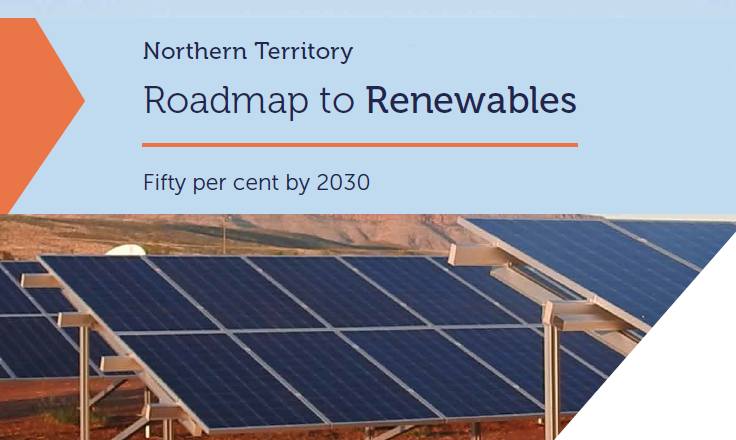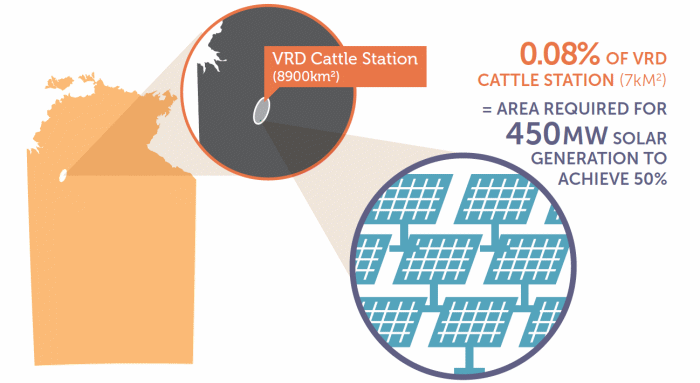
Along with the release of NT’s Roadmap To Renewables report yesterday, the Northern Territory’s government has also announced new grants for households to install solar panels.
Chief Minister Michael Gunner says the shift to renewable energy is inevitable and the Territory is well placed to take advantage of the clean power revolution.
One of Territory Labor’s election commitments was a target of 50% renewable energy by 2030, but it wasn’t quite sure how it was going to get there. There’s a lot of work to be done as the share of renewables in the Territory’s energy mix is currently just 4%, with gas and diesel-based electricity generation making up 96%.
The Roadmap To Renewables report (PDF) offers a “credible path” to reaching the 50% goal said Mr. Gunner.
The report’s Expert Panel says reaching the 50% mark presupposes an installed renewable energy capacity of approximately 450MW peak. The Northern Territory has very high solar irradiation levels, but relatively low average wind speeds – so solar PV should be the technology of choice suggests the Panel, along with energy storage.
The amount of land needed would be around 700 hectares; a tiny fraction of the NT’s 1,346,200 square kilometres. As a comparison, solar PV would cover much less than one percent of the Victoria River Downs (VRD) cattle station.

As well as large-scale projects, not to be forgotten are the existing rooftops of homes and businesses throughout the NT yet to see solar panels installed.
One of the recommendations for boosting uptake of solar power in Darwin and elsewhere is making changes to the Northern Territory feed in tariff, which is currently the most generous in Australia (1:1). The Panel suggests the FiT be adjusted to reflect electricity demand at different times of the day.
Chief Minister Gunner says his Government has accepted or accepted in principle the key 11 recommendations from the report.
“Over the coming months we will carefully and methodically undertaking the financial and economic modelling required to implement these recommendations in a way which delivers the cheapest possible power for families and businesses, and minimises the need for taxpayer investment,” said Mr. Gunner
New Solar Grants
While the NT may have the country’s best feed in tariffs, the tyranny of distance makes installing solar power systems more expensive, presenting a barrier to uptake.
Yesterday, Mr. Gunner also announced $4.5 million for co-contribution grants of up to $1,000 to households to undertake energy efficiency measures such as the installation of solar panels and battery systems. These grants would be in addition to Australia’s existing major solar subsidy. It’s not clear yet as to when the new grants will kick in.
Previous State Government initiatives offering grants for solar, such as the Home Improvement Scheme, were very popular.
Update December 12 : further details regarding the subsidy, which has been called the Smart Energy Grant, can be viewed here.

 RSS - Posts
RSS - Posts



I would like to see each state and territory in Australia, as much as possible, first act to ensure all government buildings (state/territory, and, local government, buildings, and, especially, schools) have their roof areas covered, as much as possible, with photovoltaic panels, and, have storage battery systems, to both ensure electricity continuity and maximising use of photovoltaic power, and, thence, reducing electricity costs on a long term basis, and, then , providing assistance to householders to implement domestic rooftop photovoltaic systems, with storage battery systems.
Apart from the benefits to the environment, and, to the finances of the entities that would have the rooftop photovoltaic systems with the battery storage systems, it should reduce future expenditure on infrastructure costs.
So, Queensland and the Northern Territory, appear to be starting along the path to achieving such benefits.
Now, if WA would act, to start also, along the path with a view to the future (if WA can overcome its bankruptcy due to the feral government siphoning off WA’s fair share of the GST).